Overview
Chromatography stands as a pivotal laboratory technique, essential for the separation of mixtures into their individual components. This separation is achieved based on the interactions between stationary and mobile phases, making it invaluable across various sectors, including:
- Pharmaceuticals
- Environmental science
- Food safety
The article underscores the significance of chromatography by detailing a range of methods, each with distinct advantages and practical applications. This technique not only ensures safety and compliance in multiple industries but also illustrates the continuous innovations and growth within the market. As we delve deeper, the importance of high-quality scientific instruments in laboratory settings becomes increasingly clear, showcasing how chromatography plays a critical role in advancing industry standards and practices.
Introduction
In the realm of scientific analysis, chromatography serves as a cornerstone technique, enabling researchers to separate and identify myriad components within complex mixtures. By employing principles of differential distribution between stationary and mobile phases, this versatile method finds applications across various fields, including pharmaceuticals and environmental science.
As the demand for precision and efficiency in laboratory settings escalates, the chromatography market is projected to expand significantly, driven by technological advancements and increasing investments in research and development.
This article delves into the intricacies of chromatography, exploring its principles, types, applications, and the challenges that accompany its use. Furthermore, it highlights the role of innovative solutions in enhancing analytical capabilities, underscoring the importance of high-quality scientific instruments in modern laboratories.
What is Chromatography? An Overview
Chromatography is an essential laboratory method utilized to separate mixtures into their individual components, leveraging the principle of differential distribution. In this process, the components of a mixture are distributed between a stationary phase and a mobile phase, enabling effective separation. This versatile technique finds extensive application across various scientific disciplines, including chemistry, biology, and environmental science, where chromatography examples are crucial for analyzing complex mixtures and purifying substances.
The significance of this separation technique in scientific research is profound. It plays a pivotal role in quality control, drug development, and environmental monitoring. For instance, in pharmaceutical laboratories, separation techniques are vital for ensuring the purity and potency of drugs. In environmental science, chromatography is employed to detect pollutants in water and soil samples, underscoring its critical importance.
JM Inc. bolsters these applications with its premium HPLC solutions, offering a wide range of HPLC columns, Shodex Refractive Index and Conductivity detectors, Flom HPLC degassers, and HPLC fittings. These products are essential for achieving precise and reliable results in analytical separation. Furthermore, JM Science provides competitive pricing on these offerings, ensuring accessibility for various laboratory needs.
Recent statistics reveal a robust growth trajectory for the separation market, projected to rise from USD 7.58 billion in 2025 to USD 13.23 billion by 2034. This growth is driven by increasing demand for analytical techniques in research and development, particularly within the pharmaceutical and bioinformatics sectors. Notably, North America has historically dominated the columns market due to its strong research infrastructure.
However, significant growth is anticipated in the Asia Pacific region, where manufacturers are shifting production to developing countries, driven by lower costs and increased investments in R&D. As Anushka Gore, a Research Associate at Cognitive Market Research, notes, "The dynamic landscape of market research shows that emerging markets are becoming increasingly essential for the growth of separation technologies."
Recent advancements in separation techniques include innovative products such as TetraScience's global separation dashboard, which enhances data integration and analysis, and Waters Corporation's new HPLC system, designed to improve efficiency and accuracy in laboratory workflows. JM Science's offerings, including high-performance liquid separation columns, titrators, and cutting-edge medical devices, lead these advancements, reflecting a broader trend towards incorporating artificial intelligence and sustainability in medical devices, thereby expanding the potential applications of liquid separation techniques.
Numerous chromatography examples illustrate this separation technique's practical applications. In chemistry, it is employed to separate and identify compounds in complex mixtures, such as analyzing food products for contaminants. In biology, separation methods are essential for purifying proteins and nucleic acids, facilitating vital research in genetics and molecular biology.
Overall, chromatography remains a cornerstone of analytical chemistry, with its applications continuously evolving to meet the demands of modern science. As the field progresses, the incorporation of new technologies and methodologies, alongside JM Science's innovative scientific instruments, will further enhance the capabilities and significance of this technique across various research domains.
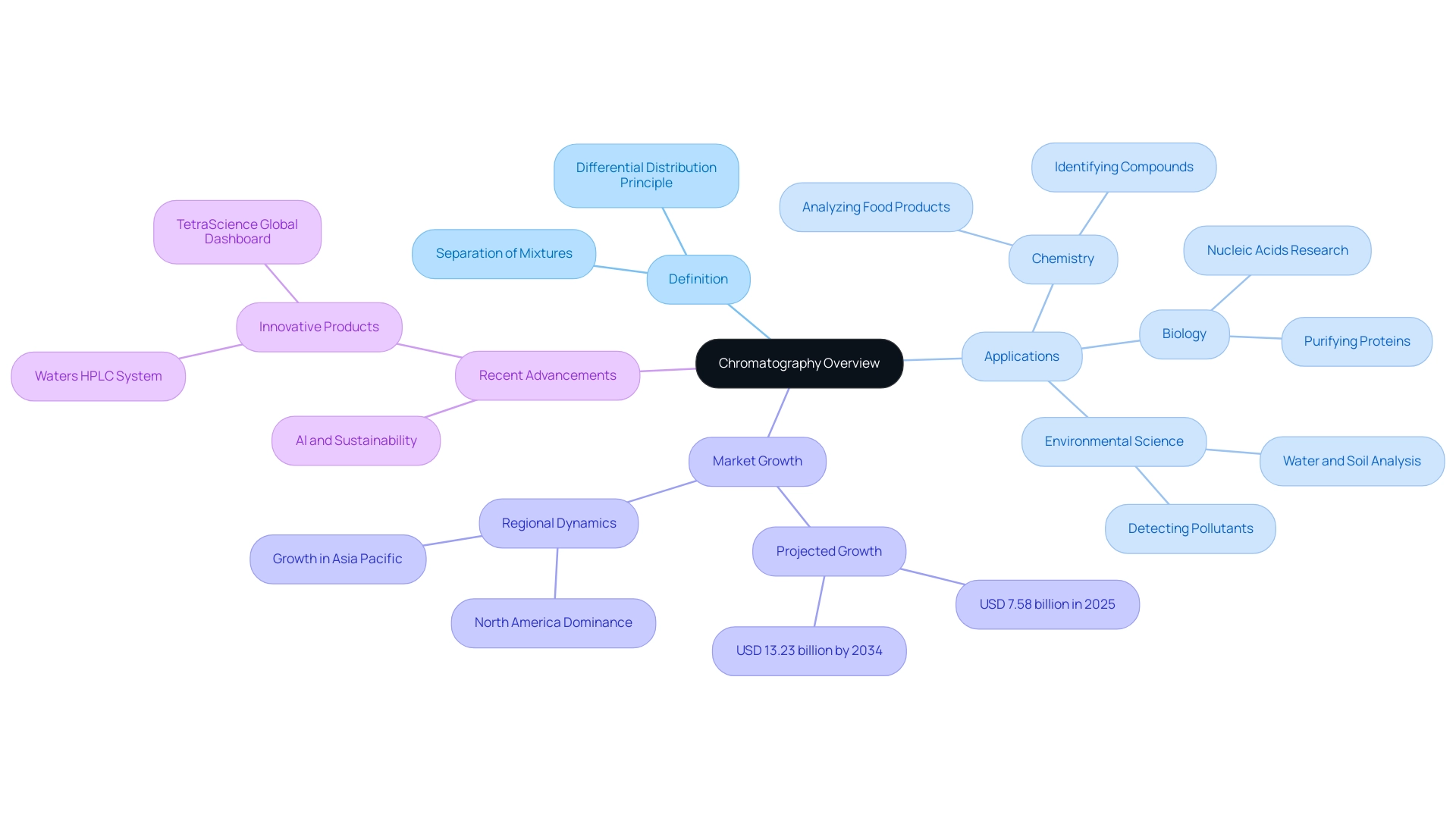
The Principles of Chromatography: How It Works
Chromatography fundamentally relies on the interactions between the components of a mixture and the stationary phase, which can be either a solid or a liquid. The mobile phase, which may be a gas or a liquid, facilitates the transport of the mixture through the stationary phase. As the mixture progresses, each component interacts with the stationary phase to varying extents, resulting in their separation based on their affinities.
This separation is manifested as distinct bands or spots on a chromatogram, enabling the analysis and identification of individual components.
Recent studies underscore the importance of understanding separation techniques, particularly the interactions between the stationary and mobile phases. For instance, the pore size distribution of the stationary phase is critical for determining the accessible pore volume specific to proteins during the separation process. This knowledge is essential for optimizing separation processes, especially in contexts involving complex mixtures.
JM Science Inc. offers a comprehensive selection of premium high-performance liquid separation components, including HPLC columns, fittings, titrators, and Karl Fischer reagents, designed to enhance these processes, ensuring laboratories achieve precise and reliable results at competitive prices.
In practical applications, various case studies exemplify chromatography principles. For example, the separation of curcuminoids illustrates the significance of model selection and statistical analysis in optimizing chromatographic processes. Advanced techniques, such as multivariate data-driven modeling, have been shown to enhance process monitoring, enabling early fault detection and diagnosis in purification unit operations.
As Konstantinos Spetsieris, Head of Data Science and Statistics at Bayer US LLC, notes, "Advanced, multivariate, data-driven modeling can enhance process monitoring for early fault detection and fault diagnosis for purification unit operations."
Moreover, chromatography examples can elucidate the interaction between stationary and mobile phases. In (HPLC), the choice of stationary phase—whether silica gel or polymer-based—significantly affects the separation efficiency and resolution of compounds. This is particularly evident in pharmaceutical applications, where precise separation is crucial for quality control and formulation development.
Notably, the count of analogous compounds utilized in the federation of local models method typically stands at 20, highlighting the intricacy and importance of meticulous model selection in separation science.
As the field of separation techniques continues to evolve, staying informed about the latest principles and methodologies is essential for laboratory managers. Incorporating statistical data and expert insights into separation practices not only enhances the understanding of separation mechanisms but also fosters innovation in analytical methods, ensuring laboratories can meet the growing demands for accuracy and efficiency in their analyses. JM Science Inc.'s commitment to quality and support, combined with its strategic focus on innovation in scientific instruments, including cutting-edge medical devices, positions it as a valuable ally for laboratories aiming to enhance their chromatography processes.
Types of Chromatography: Exploring Different Techniques
Chromatography encompasses a variety of methods, each tailored to meet specific analytical requirements.
Gas Chromatography (GC) utilizes a gaseous mobile phase, effectively separating volatile compounds. Notable chromatography techniques, such as High-Performance Liquid Chromatography (HPLC), are extensively applied in environmental testing and quality control within the pharmaceutical sector. Here, precise identification of substances is paramount. The advantages of GC include high resolution and speed, making it a preferred option in pharmaceutical applications, particularly for drug formulation and quality assurance. In contrast, Thin-Layer Chromatography (TLC) is recognized for its simplicity and cost-effectiveness, making it suitable for separating small quantities of substances on a thin layer of adsorbent material. TLC is often employed in educational settings and preliminary analyses, delivering quick results with minimal equipment.
Other chromatography methods include paper chromatography, which employs paper as the stationary phase and is frequently utilized for educational purposes and straightforward analysis. This method serves as an excellent introduction to the principles of separation techniques. Furthermore, ion chromatography specializes in the separation of ions and polar molecules based on their charge, proving essential in environmental monitoring and food safety testing, where ion concentration is critical.
Each chromatographic technique offers distinct advantages, leading to a selection process that depends on the specific analytical requirements. The market for separation techniques is projected to reach USD 10.00 billion by 2025, propelled by technological advancements and an increasing demand for high-performance resins. Notably, gas separation remains a dominant force, with significant applications in pharmaceuticals, where it plays a crucial role in drug development and quality control.
Recent insights reveal that the introduction of high-performance resins is enhancing the efficiency and effectiveness of these techniques, further solidifying their importance in laboratory settings. In North America, substantial government investments in research and a well-structured healthcare system are anticipated to drive market growth, as underscored in recent case studies. Additionally, educational initiatives like Phenomenex Inc.'s establishment of PhenoAcademy in January 2024 aim to enhance skills for researchers and chemists, reflecting a continuous commitment to advancing knowledge in this field. According to , the life sciences and biotech sector has exceeded the total amount raised in 2023, highlighting the critical role of chromatography in supporting these industries.
Applications of Chromatography in Science and Industry
Chromatography examples play a pivotal role across diverse industries, showcasing its versatility and importance in ensuring safety, compliance, and quality. Key applications include:
- Pharmaceuticals: Chromatography is essential for drug formulation, quality control, and purity testing. It enables precise separation and analysis of compounds, ensuring that pharmaceutical products meet stringent regulatory standards.
JM Inc. provides premium HPLC columns, Karl Fischer reagents, and titrators that enhance these processes, allowing for accurate and efficient analysis. Recent statistics indicate that over 70% of pharmaceutical firms employ separation methods for quality assurance, underscoring its essential role in the industry. Notably, the pharmacological effects of the ingredients from Indigo naturalis have revealed potent proliferation-inhibiting and apoptosis-promoting abilities on human chronic myelogenous leukemia cells and human promyelocytic leukemic cells (p < 0.001), highlighting the significance of chromatography examples in the context of separation techniques used in drug formulation.
- Environmental Science: This technique is vital for analyzing pollutants in air, water, and soil samples. Chromatography allows for the detection of trace contaminants, contributing to environmental monitoring and protection. In 2025, studies revealed that this analytical technique was employed in over 60% of environmental assessments, emphasizing its significance in safeguarding ecosystems.
- Food and Beverage: In this sector, this method is used to test food safety, detect contaminants, and ensure product quality. It aids in identifying harmful substances and verifying ingredient authenticity, which is crucial for consumer safety. The use of separation techniques in food testing has risen by 25% in recent years, reflecting heightened concerns regarding food safety.
- Forensics: In criminal investigations, separation methods are employed to examine substances discovered at crime scenes. This application aids in identifying drugs, toxins, and other materials, providing critical evidence in legal cases. The reliability of this analytical technique in forensic science has established it as a standard practice in many law enforcement agencies.
- Biotechnology: This method is employed for purifying proteins and other biomolecules in research and production processes. JM Science's innovative HPLC solutions, along with Shodex detectors and other HPLC accessories, are essential for developing biopharmaceuticals and ensuring the efficacy of therapeutic agents. The incorporation of chromatography examples as separation techniques in biotechnology has resulted in substantial progress in drug creation and production efficiency.
These applications not only showcase the adaptability of separation methods but also their essential role in improving safety and quality across different industries. For instance, a recent case study on stability testing optimization using chemometrics illustrated how separation techniques like Principal Component Analysis (PCA) can streamline drug stability assessments, enhancing predictive accuracy while reducing resource consumption. Additionally, the integration of Quantitative Structure-Activity Relationship (QSAR) into a Quality by Design (QbD) framework supports robust and reliable method development while minimizing environmental impact.
Furthermore, the application of Design of Experiments (DOE) to optimize enhances greenness by reducing waste and improving recovery during sample treatment. Such innovations reflect the ongoing evolution of chromatography in meeting the demands of modern science. To explore JM's full range of products, including HPLC solutions and innovative medical devices, visit our website today!
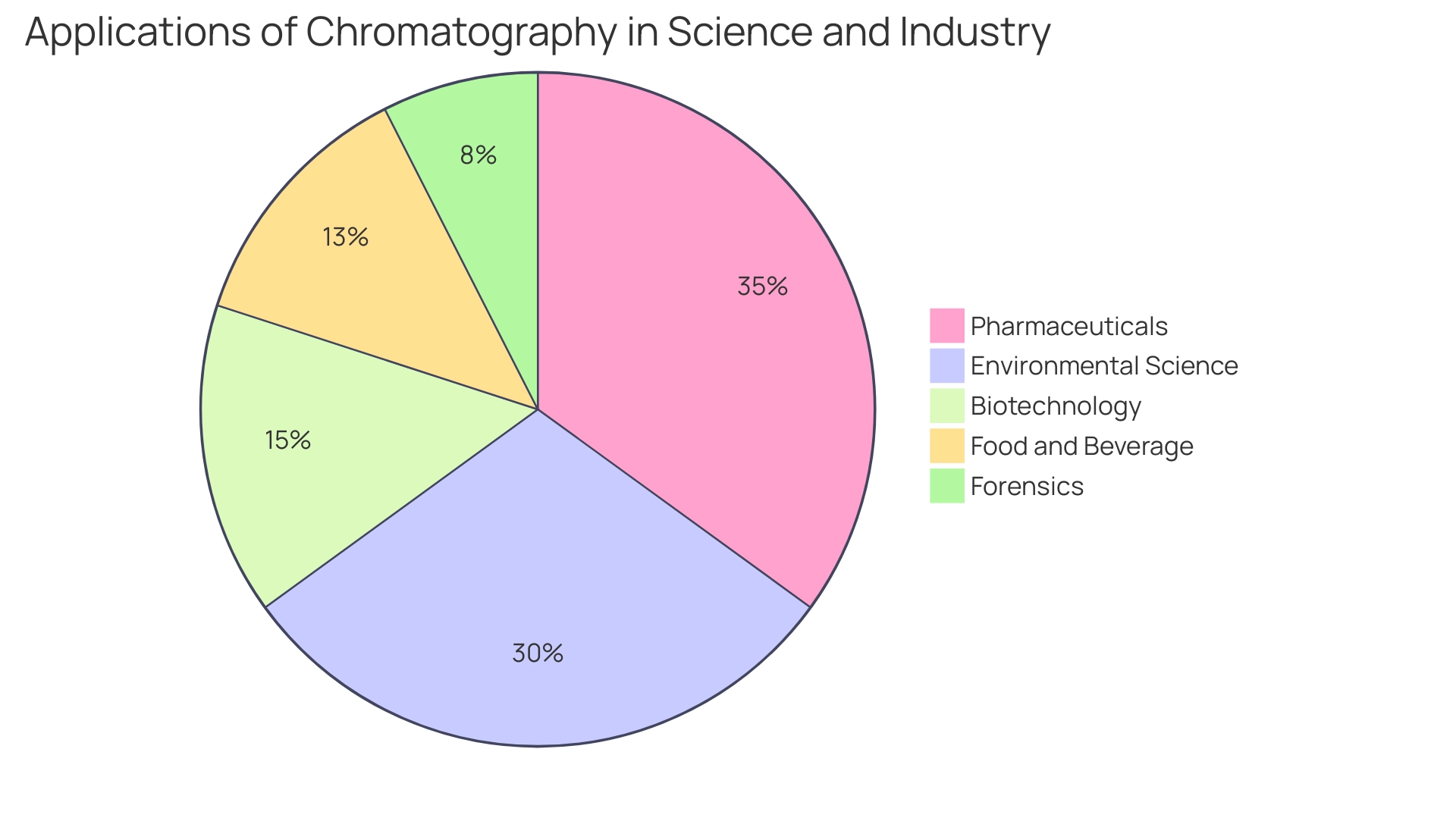
Advantages of Chromatography: Why Use This Technique?
Chromatography offers a multitude of advantages that position it as an essential tool in analytical tasks across various scientific fields, particularly with the premium instruments provided by JM Science Inc. High resolution is a hallmark of chromatography, excelling in the separation of complex mixtures with remarkable precision. This capability allows for the identification of individual components even in intricate samples, a crucial factor in pharmaceutical applications where purity and composition are paramount. JM's high-performance liquid chromatography (HPLC) columns exemplify this effectiveness, designed to deliver exceptional results in these scenarios.
Sensitivity is another key advantage of chromatography. The technique adeptly detects trace amounts of substances, which is particularly beneficial in forensic and environmental analyses. Recent advancements have demonstrated that modern chromatography can achieve detection limits in the picogram range, significantly enhancing the reliability of results. JM's innovative HPLC solutions further bolster sensitivity in analytical tasks.
The versatility of chromatography is evident in its application across a diverse array of substances, including gases, liquids, and solids. This adaptability renders chromatography suitable for various industries, from pharmaceuticals to food safety, ensuring comprehensive analysis across different matrices. JM Science's extensive range of HPLC columns and accessories provides numerous examples of chromatography that support this versatility, catering to a variety of analytical needs.
Speed is a crucial factor in laboratory efficiency, and many chromatography examples illustrate that chromatographic techniques yield rapid results. For instance, high-performance liquid chromatography (HPLC) can deliver results in a matter of minutes, facilitating quicker decision-making in research and quality control processes. JM's HPLC systems are engineered for high throughput, ensuring laboratories can meet demanding timelines.
Scalability is another significant feature of chromatography. Various chromatography methods can be customized for both small-scale research and large-scale industrial use. This scalability allows laboratories to optimize their processes according to specific needs, whether conducting preliminary studies or full-scale production. JM's offerings include a variety of chromatography examples, such as HPLC configurations adaptable to different scales of operation.
In addition to chromatography, JM Science provides premium titrators and Karl Fischer reagents, essential for . These products, paired with competitive pricing, ensure that laboratories have access to high-quality instruments, including various chromatography examples, at exceptional value.
These advantages underscore why chromatography is often the preferred option for sensitive analyses. A recent case study titled "Chemometrics to Aid in Sustainable Stability Testing" illustrates how integrating advanced analytical methods can enhance predictive accuracy and sustainability in pharmaceutical development. By employing methods such as Multivariate Data Analysis (MDA) and Partial Least Squares (PLS) regression, companies can significantly improve the efficiency of stability testing, reducing resource consumption while ensuring drug safety and efficacy.
Ongoing research continues to emphasize the benefits of chromatography. A recent article in the Journal of Chromatography A explores innovative machine learning methods that enhance the distinction and verification of complex herbal products, highlighting the field's contribution to advancing analytical capabilities. This study emphasizes the importance of utilizing a sufficiently large dataset with various analytes and chromatographic conditions to improve prediction accuracy and stability.
In summary, the high resolution and sensitivity of chromatography, coupled with its versatility and efficiency, make it an indispensable tool in modern laboratories, driving advancements in research and quality assurance. As Torgny Fornstedt observed, the incorporation of such advanced methods is essential for the ongoing evolution of analytical practices in the pharmaceutical industry. Explore JM Science's range of products today to enhance your laboratory's analytical capabilities.
Limitations of Chromatography: Understanding the Challenges
While this analytical method serves as a powerful tool, it is not without its limitations. Understanding these constraints is crucial for optimizing methods and managing expectations in laboratory settings.
- Cost: The investment in high-quality chromatography equipment and solvents can be substantial. As of 2025, the average cost of advanced chromatographic systems has risen, reflecting the increasing demand for precision and reliability in analytical results. This financial burden can pose a significant barrier for smaller laboratories or those with limited budgets. Notably, the article discussing these trends was published in 2018, indicating a long-standing concern in the field.
- Time-Consuming: The process of method development and sample preparation can be labor-intensive and time-consuming. Laboratories often face delays due to the need for extensive optimization to achieve reproducible results. For instance, a recent study highlighted that method validation can take weeks, impacting overall productivity.
- Complexity: Many chromatographic processes require specialized training and expertise. This complexity can lead to operational challenges, particularly in environments where staff turnover is high. Expert commentary from Johanna Engelke emphasizes the importance of ongoing training to ensure that personnel are equipped to handle sophisticated equipment effectively. Additionally, the necessity for suitable auxiliary and complementary analytical methods is emphasized, highlighting the complexities involved in chromatography.
- Sample Limitations: Not all samples are suitable for chromatographic analysis. Samples that are highly viscous or contain particulate matter can pose significant challenges, leading to poor separation and unreliable results. Recent challenges in chromatographic analysis have underscored the need for alternative methods or pre-treatment processes to prepare such samples adequately. A notable case study on vendor-independent color-coding for chromatographic data illustrates how innovative approaches can enhance data interpretation. This method, which utilizes mass spectra to assign colors to peaks, and helps address some limitations by providing a more intuitive understanding of analyte identities. By offering solutions that incorporate such innovative techniques, JM Science demonstrates its commitment to continually updating its product offerings and maintaining strong relationships with top manufacturers, thereby addressing the challenges faced by laboratories in this analytical method.
In summary, while chromatography serves as a cornerstone of analytical chemistry, awareness of its limitations—such as cost, time, complexity, and sample suitability—enables laboratories, particularly pharmaceutical lab managers, to navigate the challenges they face and optimize their analytical strategies.
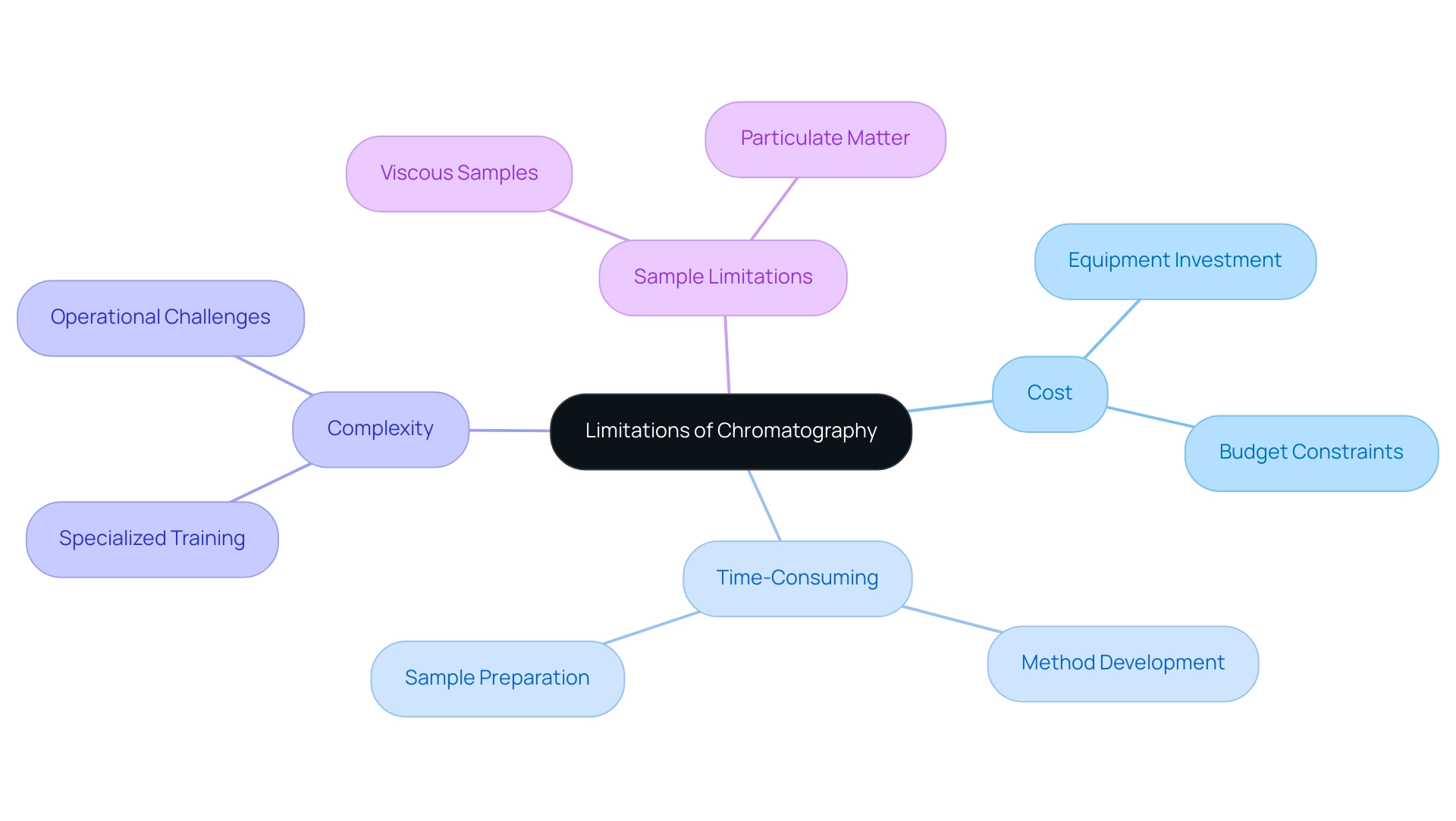
Real-World Examples of Chromatography in Action
Chromatography plays a pivotal role in various sectors, with notable real-world applications that underscore its importance. In the realm of sports, chromatography is essential for analyzing urine samples to detect illegal substances. Recent advancements in multiplex screening methods have enabled laboratories to efficiently test multiple drugs in oral fluid samples, yielding results comparable to traditional urine analyses. This innovation enhances the accuracy of drug testing while streamlining the process, making it more efficient for regulatory bodies. However, as noted by Debby Mangelings, a professor at the Vrije Universiteit, Belgium, "A major problem with chiral separations is that enantioselectivity cannot be predicted," highlighting ongoing challenges in this area.
Liquid separation techniques are widely employed to test for pesticide residues in fruits and vegetables, ensuring that food products meet safety standards. Studies have shown that chromatography can effectively identify and quantify pesticide levels, helping to protect consumers from harmful exposure. This program is critical as food safety regulations become increasingly stringent.
Chromatography is utilized to analyze water samples for contaminants, including heavy metals and organic pollutants. This application is vital for maintaining environmental health and compliance with regulatory standards. By employing , researchers can detect trace levels of pollutants, contributing to efforts in environmental protection and public health.
In medical environments, this analytical technique is instrumental in separating and identifying compounds in blood samples, aiding in the diagnosis of metabolic disorders. This application highlights the technology's significance in clinical laboratories, where precise measurements are crucial for patient care. The combination of separation techniques with laboratory information management systems (LIMS) enhances operational efficiency, allowing for better data management and analysis in drug testing and environmental monitoring.
These chromatography examples illustrate the critical role of this technique in ensuring safety and compliance across various sectors. As we look towards 2025, the ongoing evolution of separation techniques continues to support advancements in drug testing, food safety, and environmental monitoring, reinforcing its status as an indispensable tool in scientific research and industry practices. Furthermore, the strategic alliance formed in November 2024 between Sepragen Corporation and Shimadzu Corporation exemplifies the evolving landscape of the separation science market, enhancing capabilities in drug testing and biopharmaceutical applications.
As highlighted by experts, the unpredictability of enantioselectivity in chiral separations remains a challenge, emphasizing the need for continuous innovation in this field. Moreover, educational organizations such as the chemistry department at William & Mary are essential in training experts for these challenges, underscoring the significance of separation techniques education in pharmaceutical labs.
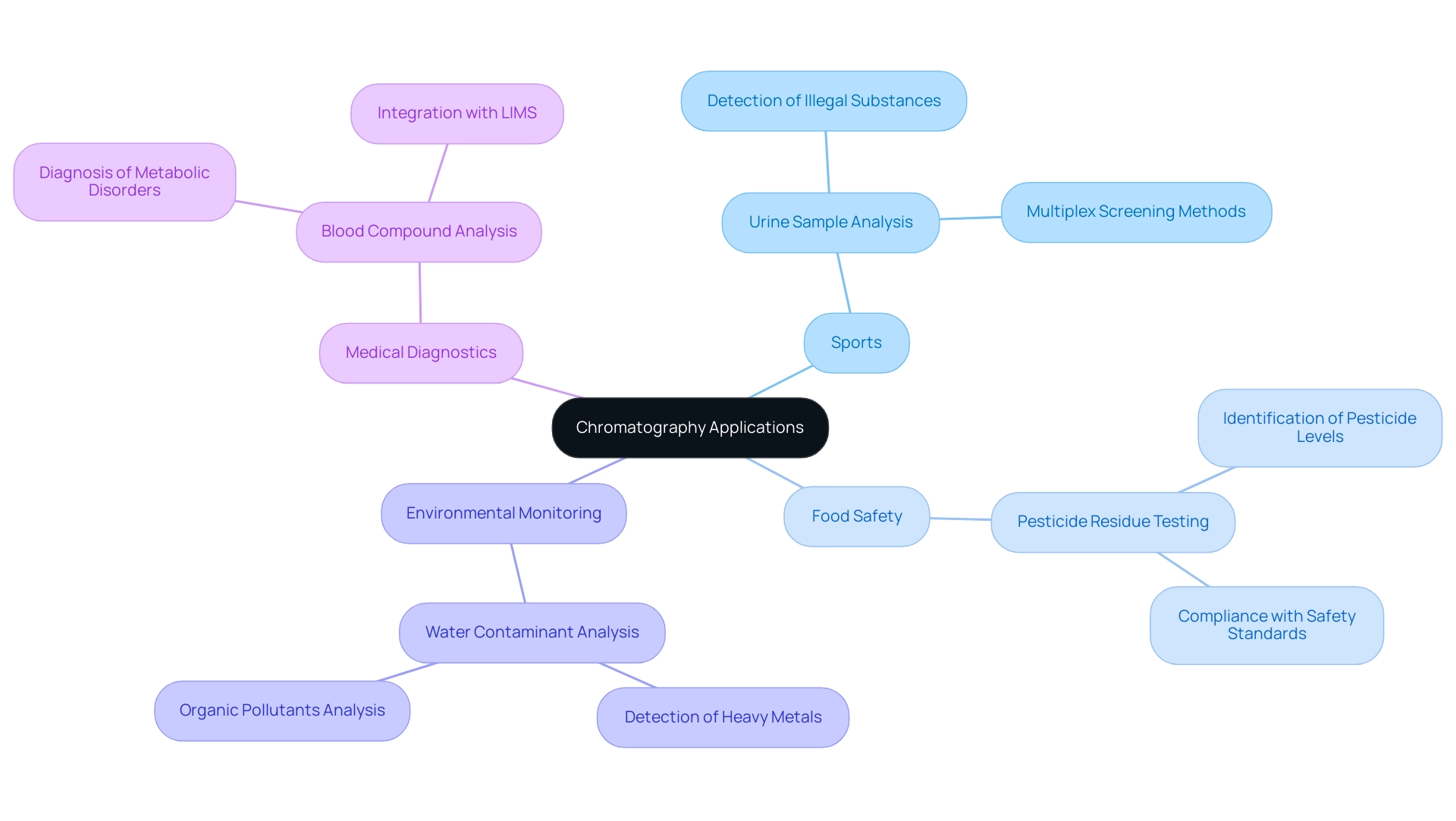
Key Takeaways: Understanding Chromatography
Chromatography serves as a vital analytical technique for the separation and analysis of mixtures across various scientific disciplines. At its core, chromatography operates on the principle of differential distribution between stationary and mobile phases, facilitating the effective separation of components based on their unique interactions with these phases. Different types of chromatography, including high-performance liquid chromatography (HPLC), gas chromatography (GC), and thin-layer chromatography (TLC), are tailored for specific applications. For instance, HPLC, a key offering from JM Research Inc., is extensively utilized in pharmaceutical research for the analysis of drug compounds.
JM offers a comprehensive range of HPLC columns and accessories, such as Shodex, CapcellPak, and Reprosil columns, designed to meet the diverse needs of laboratories. Additionally, JM Science provides titrators and Karl Fischer reagents, further enhancing its collection of premium scientific instruments.
The applications of separation techniques, particularly chromatography, are vast, extending to critical areas such as pharmaceuticals, environmental monitoring, food safety, and clinical diagnostics. A notable recent advancement in this field is the launch of the Everest GC4500 in March 2024, which specializes in profiling fatty acids and triglycerides in milk fat. This innovation underscores the technique's adaptability to meet industry requirements and highlights the ongoing progress in separation science.
Recent statistics indicate that the market for chromatography technology is experiencing substantial expansion, especially in the Asia Pacific region, which is emerging as the fastest-growing sector in this field, driven by advancements in pharmaceuticals and chemicals. This trend emphasizes the increasing significance of chromatography as an analytical technique in both scientific research and industry.
Despite its numerous advantages, such as high sensitivity and resolution, chromatography does have limitations, including the requirement for skilled operators and potential challenges with sample preparation. Understanding these factors is essential for users aiming to enhance the efficiency of separation techniques in their analyses. Furthermore, a case study on the global growth of separation reagents illustrates how prominent companies, including JM, are establishing production facilities and distribution systems in developing markets with considerable growth potential.
This strategy is expected to boost market share and stimulate growth in , particularly in regions with rising demand.
In summary, by grasping the fundamental principles and diverse applications of chromatography, beginners can better appreciate the technique's importance in advancing scientific research and improving industry practices. The continuous innovations and expert insights into chromatography, particularly from JM Science's premium scientific instruments, further underscore its critical role in shaping the future of analytical science.
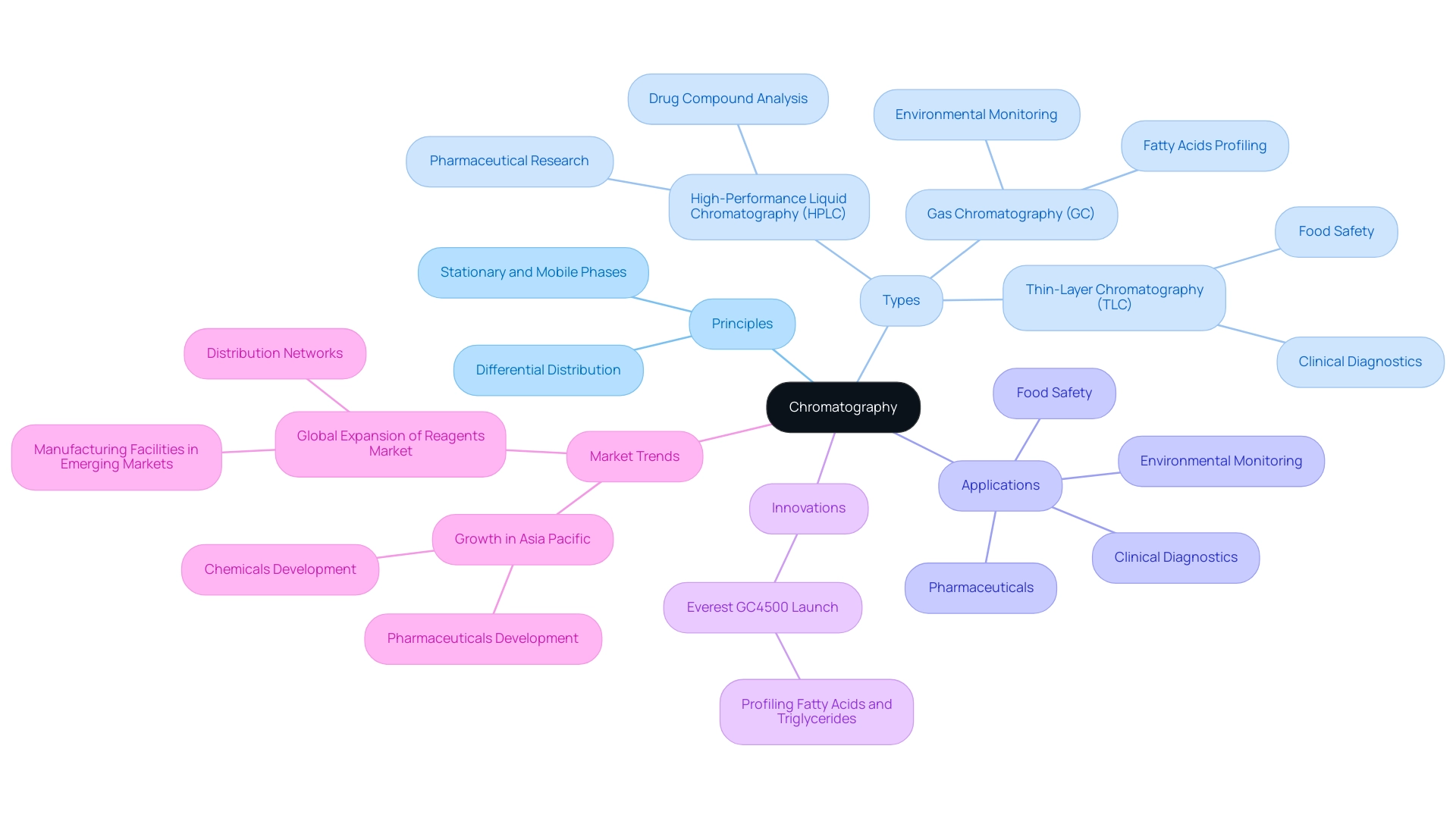
Conclusion
Chromatography stands as a pivotal analytical technique across various scientific disciplines, providing essential capabilities for separating and analyzing complex mixtures. This article underscores the fundamental principles of chromatography, detailing how different techniques—such as high-performance liquid chromatography (HPLC), gas chromatography (GC), and thin-layer chromatography (TLC)—are meticulously tailored to meet specific analytical needs. Each method showcases unique advantages, emphasizing the critical importance of selecting the appropriate technique based on the requirements of the analysis.
The applications of chromatography are extensive, spanning critical areas such as pharmaceuticals, environmental monitoring, food safety, and clinical diagnostics. With ongoing advancements in technology and methodology, the chromatography market is projected to experience significant growth, particularly in emerging regions like Asia Pacific. This trend underscores the increasing reliance on chromatography for ensuring safety, compliance, and quality across various industries.
Despite its advantages, chromatography also faces challenges, including high costs, time-consuming processes, and the necessity for specialized training. Understanding these limitations is crucial for laboratories aiming to optimize their analytical strategies. Continued innovation in chromatography techniques, coupled with high-quality instruments from manufacturers like JM Science Inc., is vital for addressing these challenges and enhancing the capabilities of modern laboratories.
In conclusion, chromatography is not merely a cornerstone of analytical chemistry; it represents a dynamic field that continually evolves to meet the demands of modern science. As researchers and industries harness the power of chromatography, its role in advancing scientific knowledge and ensuring public safety will only grow more significant. Embracing this technique will undoubtedly lead to improved outcomes in both research and industry practices alike.




